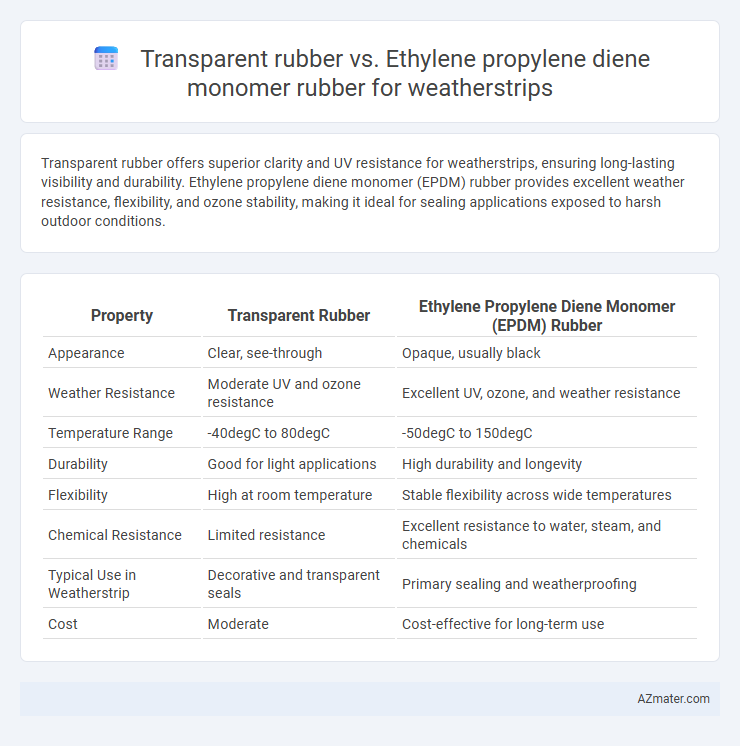Transparent rubber offers superior clarity and UV resistance for weatherstrips, ensuring long-lasting visibility and durability. Ethylene propylene diene monomer (EPDM) rubber provides excellent weather resistance, flexibility, and ozone stability, making it ideal for sealing applications exposed to harsh outdoor conditions.
Table of Comparison
| Property | Transparent Rubber | Ethylene Propylene Diene Monomer (EPDM) Rubber |
|---|---|---|
| Appearance | Clear, see-through | Opaque, usually black |
| Weather Resistance | Moderate UV and ozone resistance | Excellent UV, ozone, and weather resistance |
| Temperature Range | -40degC to 80degC | -50degC to 150degC |
| Durability | Good for light applications | High durability and longevity |
| Flexibility | High at room temperature | Stable flexibility across wide temperatures |
| Chemical Resistance | Limited resistance | Excellent resistance to water, steam, and chemicals |
| Typical Use in Weatherstrip | Decorative and transparent seals | Primary sealing and weatherproofing |
| Cost | Moderate | Cost-effective for long-term use |
Introduction to Weatherstrip Materials
Weatherstrip materials such as transparent rubber and ethylene propylene diene monomer (EPDM) rubber serve critical functions in sealing gaps and protecting against environmental elements. Transparent rubber offers aesthetic advantages and flexibility, making it suitable for applications requiring visibility and a seamless look. EPDM rubber excels in durability, weather resistance, and UV stability, making it the preferred choice for outdoor weatherstripping in automotive, construction, and industrial sectors.
Overview of Transparent Rubber
Transparent rubber offers exceptional clarity and flexibility, making it ideal for weatherstrips where visibility and aesthetics are important alongside sealing performance. Unlike Ethylene Propylene Diene Monomer (EPDM) rubber, which excels in durability and resistance to weathering, ozone, and heat, transparent rubber provides a visually appealing seal but may have reduced resistance to harsh environmental factors. The choice between transparent rubber and EPDM depends on balancing the need for transparency with mechanical and environmental durability requirements in weatherstrip applications.
Ethylene Propylene Diene Monomer (EPDM) Rubber Explained
Ethylene Propylene Diene Monomer (EPDM) rubber excels in weatherstrip applications due to its exceptional resistance to ozone, UV rays, and extreme temperatures, ensuring long-lasting durability in harsh outdoor environments. Unlike transparent rubber, EPDM offers superior flexibility and robust mechanical properties, making it ideal for sealing and insulating automotive and architectural seals. Its chemical inertness and resistance to water and steam further enhance its performance in weatherstripping, providing reliable protection against air and moisture infiltration.
Physical Properties Comparison
Transparent rubber exhibits excellent clarity and moderate tensile strength, making it ideal for applications requiring visibility and flexibility in weatherstrips. Ethylene propylene diene monomer (EPDM) rubber offers superior weather resistance, high tensile strength, and excellent resistance to ozone, UV rays, and extreme temperatures, ensuring longer durability in outdoor weatherstripping applications. While transparent rubber emphasizes aesthetic appeal and flexibility, EPDM excels in physical resilience and environmental endurance, key factors for performance in sealing and insulation tasks.
Weather Resistance: Transparent Rubber vs EPDM
Transparent rubber offers moderate weather resistance but tends to degrade faster under prolonged UV exposure and harsh environmental conditions compared to Ethylene Propylene Diene Monomer (EPDM) rubber. EPDM exhibits superior resistance to ozone, UV rays, temperature extremes, and moisture, making it the preferred choice for weatherstripping applications requiring long-lasting durability. Its molecular structure provides excellent elasticity and resilience, ensuring effective sealing performance across diverse climates.
UV and Ozone Stability in Both Materials
Transparent rubber exhibits lower UV and ozone stability compared to Ethylene Propylene Diene Monomer (EPDM) rubber, making it more prone to degradation and discoloration when exposed to prolonged sunlight and atmospheric ozone. EPDM rubber, widely recognized for its superior resistance to UV radiation and ozone attack, maintains mechanical integrity and flexibility over extended outdoor use, crucial for weatherstrip applications. The enhanced durability of EPDM in harsh environmental conditions significantly reduces maintenance and replacement costs, outperforming transparent rubber in longevity and weather resistance.
Transparency and Aesthetic Considerations
Transparent rubber offers superior clarity and aesthetic appeal for weatherstrips, making it ideal for applications where visibility and design are critical. Ethylene propylene diene monomer (EPDM) rubber, while known for excellent weather resistance and durability, lacks transparency and typically appears opaque, limiting its use in visually sensitive areas. Choosing transparent rubber enhances the overall look of automotive or architectural weatherstripping by maintaining clear sightlines and a cleaner appearance.
Durability and Lifespan Assessment
Transparent rubber offers moderate durability and a shorter lifespan when used in weatherstripping applications due to its lower resistance to UV radiation, ozone, and temperature extremes. Ethylene Propylene Diene Monomer (EPDM) rubber exhibits superior weather resistance, maintaining elasticity and structural integrity for 10 to 20 years, resisting UV rays, ozone, and harsh environmental conditions. EPDM's enhanced durability and longer lifespan make it a preferred material for weatherstrips exposed to outdoor elements.
Cost and Manufacturing Differences
Transparent rubber offers aesthetic appeal but tends to be more expensive and complex to manufacture due to its clarity requirements and specialized compounding processes. Ethylene propylene diene monomer (EPDM) rubber is cost-effective, widely available, and easier to process, making it a preferred choice for weatherstripping in large-scale production. The manufacturing of EPDM involves simpler extrusion or molding techniques, while transparent rubber often requires precise control over polymer purity and additives, increasing production costs.
Conclusion: Choosing the Right Weatherstrip Rubber
Transparent rubber offers excellent visibility and aesthetic appeal for weatherstrip applications, ideal where product appearance matters. Ethylene propylene diene monomer (EPDM) rubber provides superior resistance to UV rays, ozone, extreme temperatures, and weather conditions, making it highly durable for outdoor and automotive weatherstripping. In conclusion, EPDM rubber is the preferred choice for weatherstrip durability and longevity, while transparent rubber suits applications requiring clarity and design visibility.

Infographic: Transparent rubber vs Ethylene propylene diene monomer rubber for Weatherstrip
 azmater.com
azmater.com